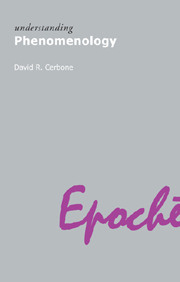Book contents
- Frontmatter
- Contents
- Acknowledgements
- Abbreviations
- Introduction: opening exercises
- 1 Husserl and the project of pure phenomenology
- 2 Heidegger and the existential turn
- 3 Sartre and subjectivity
- 4 Merleau-Ponty and the phenomenology of embodiment
- 5 Problems and prospects: phenomenology and its critics
- Questions for discussion and revision
- Further reading
- References
- Index
Introduction: opening exercises
- Frontmatter
- Contents
- Acknowledgements
- Abbreviations
- Introduction: opening exercises
- 1 Husserl and the project of pure phenomenology
- 2 Heidegger and the existential turn
- 3 Sartre and subjectivity
- 4 Merleau-Ponty and the phenomenology of embodiment
- 5 Problems and prospects: phenomenology and its critics
- Questions for discussion and revision
- Further reading
- References
- Index
Summary
Introducing a book on phenomenology, indeed introducing phenomenology, is no easy matter, in part because there are so many ways to begin and no one way is ideal. The difficulty is compounded by the fact that, as will become apparent in the chapters to follow, there is a great deal in the way of technical vocabulary and concepts associated with phenomenology, but to begin by making use of such terminology will only add to whatever confusions arise from reading the primary texts. Since phenomenology has a relatively well-defined history, commencing at the start of the twentieth century (with some nineteenth-century premonitions), along with a generally agreed on set of central figures, a book introducing phenomenology could begin historically, with a recitation of various names, dates and places. Lacking, however, would be any sense of why select just these names to the exclusion of others, and what it is that is holding them all together. The historical development of phenomenology will be one of the themes of this book, and so there will be ample opportunity for names and dates as we proceed.
Th ere is, of course, the word “phenomenology” itself, but its meaning, the study or science of phenomena, only raises more questions: phenomena as opposed to what, and what does it mean to study, or have a “science” of, phenomena (whatever they turn out to be)?
- Type
- Chapter
- Information
- Understanding Phenomenology , pp. 1 - 10Publisher: Acumen PublishingPrint publication year: 2006



